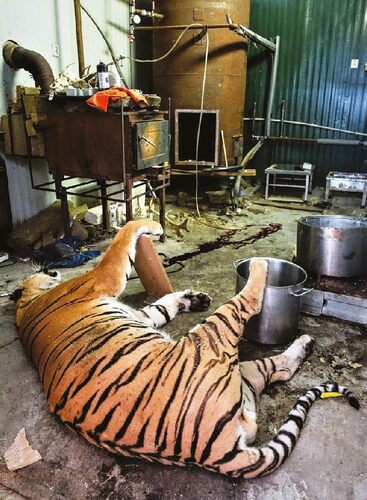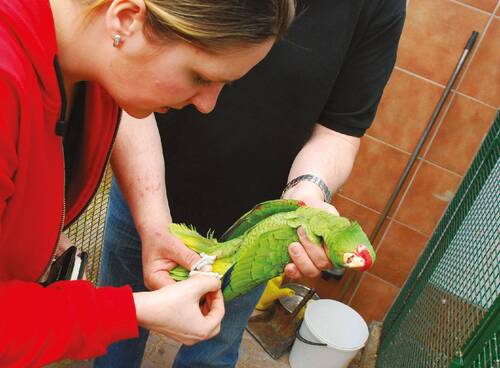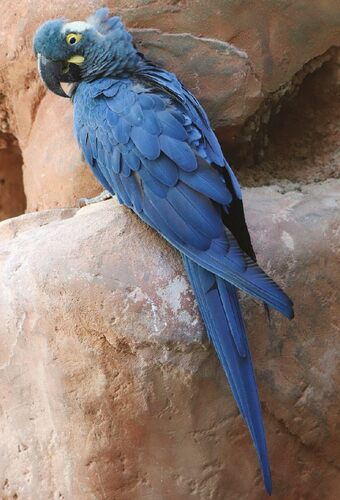Nature Conservation 2024 — 30. 5. 2024 — International Nature Conservation — Print article in pdf
CITES Fifty Years Old. Notes on What Was, Is and Will Be

If there are no customers, there will be no illegal wildlife trade.
Jane Goodall interviewed by Lauren Kearney (2016)
Five decades provide a suitable possibility to consider the birthday person’s life up to now and in future. Therefore, on the occasion of the 50th anniversary of the Convention on International Trade in Endangered Species of Wild Fauna and Flora (CITES) we not only remember establishment and mission of the important international hard law but we also try, although with a certain amount of subjectivity, to assess its implementation in the Czech Republic.
It did not start from scratch
A quick boom of human civilisation after World War II, rightly called the Great Acceleration, had resulted not only in unprecedented global economic growth. It was also reflected by permanently increasing human pressure on the environment. Thus, as early as in the 1960s, unequivocal evidence of its significant degradation and destruction began to appear in various parts of the world. It was obvious that the process became a global issue with all negative consequences.
Responses to rather unfavourable trend included, in addition to civil society rising particularly in the United States, West Europe and Japan, efforts of governments to negotiate an international multilateral agreement, i.e. a legally binding treaty, on a certain aspect of the global environmental crisis. Various declarations, appeals and petitions or national legislation in the individual countries had simply been not sufficient to solve difficulties caused by the continuing environmentally unfriendly approach of humans.

In the Czech Republic a gang dealing with captive tigers (Panthera tiger) and distribution of products made from these big cats, e.g. bouillons or tiger wine, was active. The chain included both a tiger breeder and a middleman, a processor/taxidermist and a Vietnamese trafficker with a follow-up clientele. It was the very first case of unravelling such a trade in Europe. © Police of the Czech Republic archive

The European Union became an official Party to CITES in July 2015. The EU’s common positions on the related issues are developed and agreed by the Working Party on International Environment Issues (WPIEI) CITES. A photo presents its meeting during the Presidency of the Czech Republic in the Council of the European Union in Brussels in October 2022. © Jan Plesník
At the beginning of the 1970s three topics global agreements should dealt with crystallized. In addition to the most threatened ecosystems, i.e. wetlands, and urgent necessity to effectively preserve examples of natural and cultural heritage of humankind, attention was justly paid to international trade in wild flora and fauna and in products from them. As early as in 1963, delegates of the 8th General Assembly of IUCN (International Union for Conservation of Nature) held in Nairobi, Kenya, adopted a resolution asking for negotiating such a treaty as soon as possible. Six years later, when the most important international non-governmental organisation, whose membership also includes States and government agencies, met in New Delhi, India, both a draft of the convention’s text as well as a preliminary list of taxa to dealt with were submitted for consider. The latter was based on at that time fresh novelty – the first Red Data Book (Fisher et al. 1969).
There was “only” task left, namely how to move efforts to negotiate a new international law to an intergovernmental level. It happened in late May and early June 1972 when the United Nations Conference on the Human Environment was organized in Stockholm. During the very first action aiming at the global environment resolution requiring negotiation of the treaty was adopted. The requirement was put into effect from 12 February to 3 March 1973 where acceptable consensus had finally been reached after exhausting negotiations and 80 countries agreed the treaty’s full text in the Pentagon, famous headquarters building of the United States Department of Defence in Washington, D.C. The Convention on International Trade in Endangered Species of Wild Fauna and Flora was opened to the world’s governments for signature just on 3 March 1973. That is why pursuant to the United Nations General Assembly decision, 3 March has been celebrated as the World Wildlife Day (WWD) since 2014. Moreover, the WWD is sometimes explained as the celebration of wilderness which is incorrect: it contradicts the meaning of the holiday (Plesník 2019).

At the present, almost one third of cacti (Cactaceae) species has been threatened by extinction. Together with rare orchid species and some carnivorous plants, they are among the most often smuggled plants and this black market has been continuously increasing. © Jan Plesník
It is no secret that, in addition to IUCN, the United States were a key player in the negotiations. In the U. S. breakthrough Endangered Species Act (ESA) was at that time under preparation: its competences also include significantly control of import and export of threatened species that do not occur in the United States there but that face a high risk of extinction in the wild. American lawmakers insisted on the similar control to be applied also by other countries so that U.S. citizens would not be disadvantaged in this respect (Plesník 2022). Therefore, the final spurt in negotiating CITES took place just in the U.S. capital. Nevertheless, representatives of some countries were absent there protesting against the Vietnam War.
CITES entered into force on 1 July 1975 when first ten United Nations Member States had become a Party to the Convention (Sand 1997, Oldfield 2002, Wijnstekker 2011).
|
Why CITES also deals with wildlife products
Products made from wildlife species protected by CITES include various articles from corals, skins, furs, pelts, ivory, turtle/tortoise-shell, rare tropical timber, but also hunting trophies, souvenirs, delicacies and more and more often traditional medicine products, mainly those used in East Asia. |
From the black sheep of the family to a shopwindow
As early as during negotiating CITES, thanks to extraordinary boom in plant growing, cultivation and animal keeping and breeding the former Czechoslovakia was among the world powers in this field. In addition, many Czechoslovak citizens brought home particularly from international business trips living wildlife for making some extra money: let us mention for all e.g. well-known parrots - Cuban amazons (Amazona leucocephala) or various reptiles from Vietnam.
Although the then Ministry of Culture of the Czech Socialist Republic, which was in charge of nature conservation, was seeking to make Czechoslovakia a Party to CITES but it failed. Moreover, pursuant to Article X of the Convention, it issued permits for import and export of taxa covered by CITES. For wildlife trade with States not a Party to the Convention the Parties to CITES require where export or re-export is to, or import is from, a State not a Party to the present Convention, comparable documentation issued by the competent authorities in that State which substantially conforms with the requirements of the present Convention for permits and certificates may be accepted in lieu thereof by any Party. By 1990, expert opinions were elaborated by the then State Institute of Care of Cultural Monuments and Nature Conservation, later the newly established Czech Institute for Nature, checked by the CITES Secretariat.
At the end of 1991, a thoroughly prepared proposal to joint CITES had been submitted to the Government of the Czech and Slovak Federal Republic (CSFR). Because there was no legislation specifically dealing with the topic, the federal Ministry of Foreign Affairs did not agree. Finally, its statement was voted down and the federal government assigned Minister of Foreign Affairs to secure accession to CITES by the CSFR and governments of the Czech Republic and Slovak Republic to implement the Convention. On 28 May 1992 the then Czechoslovakia become the 114th Party to CITES. After splitting the CSFR, in April 1993 it was announced that the Czech Republic as a successor state of the CSFR has become a Party to CITES since 1 January 1993.

Various populations of the well-known Nile crocodile (Crocodylus niloticus) are listed in CITES Appendix I or II: they also include populations having been recently described as the separate species named West African crocodile (Crocodylus suchus) by molecular genetic techniques. © Jan Plesník

A proposal for including the West Caucasian tur (Capra caucasica) in CITES Appendix II was initiated by the Czech Republic, namely the Nature Conservation Agency of the Czech Republic and Olomouc Zoological Garden, and was submitted by the European Union together with Georgia. The attractive ungulate is a popular trophy game. © Jan Plesník
Euphemistically said, from a point of view of the international wildlife trade the turbulent 1990s did not presented Czechoslovakia in a good light, rather on the contrary. Cases of breaking the international law often by professional breeders, keepers, growers and smugglers (if they were not the same persons) were not rare and damaged country’s good name. Birds of prey (Accipitriformes, Falconiformes) went through Czechoslovakia, namely the Czech Republic from post-Soviet countries: in addition, their nests were robbed also within Czechoslovakia. Terrestrial turtles were also massively smuggled from the former U.S.S.R. A certain company tried to reexport 2,200 skins of the Grey wolf (Canis lupus) originated from Mongolia to the United States. Parrot breeders and cacti growers were active in this respect, too and many fans of reptile breeding had not been attracted by traditionally visited Balkan Peninsula and former Soviet Central Asia anymore (Kučera & Le Duc 1992).
Contrary to many other multilateral agreements aiming at biological diversity CITES has readily available relatively effective mechanisms how to enforce Parties to fulfil obligations they voluntarily claimed responsibility for. The Parties have to take appropriate measures to enforce the provisions of the Convention and to prohibit trade in specimens in violation thereof. These must include measures: to penalize trade in, or possession of, such specimens, or both; and to provide for the confiscation or return to the State of export of such specimens. In addition, each Party has to designate one or more Management Authorities competent to grant permits or certificates on behalf of that Party; and one or more Scientific Authorities. Therefore, each Party has to have the appropriate legislation, inter alia, setting penalties and other punishments for its breaking and allowing to confiscate the respective specimens or products. If a country is consistently not implementing CITES provisions, after some unsuccessful repeated alerts from the Secretariat, the other Parties can suspend trade in specimens of CITES-listed species with the guilty country displaying non-compliance with the Convention. The Czech Republic was facing such a suspension. Therefore, like a waving a Harry Potter’s magic wand, notorious breeders, keepers and growers who complained to then political bosses about CITES perfidiously reducing powers of the invisible hand of the market, became zealous advocates of immediate passing the for a long-time postponed law.
Thus, Act No. 16/1997 Gazette on the Conditions for Importing and Exporting Endangered Species of Wild Fauna and Flora and on Amendment of the Czech National Council Act No. 114/1992 Gazette on Nature Conservation and Landscape Protection, as amended later, really entered into force on 1 April 1997. After joining the European Union on 1 May 2004, it was replaced by Act No. 100/2004 Gazette on Trade in Endangered Species.
Passing the former Act has substantially improved CITES implementation in the Czech Republic. The respective CITES national authorities (Management, Scientific and Enforcement) began to act pursuant their competencies and from the very beginning, they really have fulfilled the commitments arisen from CITES, not for the sake of appearance, as it sometimes is a bad habit. Justified attention was paid to communication with, education of and raising awareness among both the general public and the target groups aiming at reducing and limiting demand for protected wildlife and wildlife products.

For the unequivocal identification, live mammals are marked by microchip transponders. Ring-tailed lemurs (Lemur catta) from Madagascar are often kept in captivity and traded. © Jan Plesník

Although appetite for elephant tusks had been dampened by both the world wars, in the late 1980s only one tenth of the original African savanna/bush elephant (Loxodonta africana) numbers. Therefore, just on 1 January 1990 global ban on ivory trade entered into force within CITES. Nevertheless, at the beginning of the new millennium, a new wave of poaching the above large mammals again surged. © Jan Plesník
At the same time the Czech Republic has strengthened its position as a real global power in plant growing, cultivation and planting and in animal keeping and breeding, despite restrictions caused by the COVID-.19 syndemic: the Czech Republic is e.g. one of the largest exporters of small parrots in the world (Plesník et al. 2020). When taking into account the European average, number of permits on international trade in wildlife and wildlife products issued in the Czech Republic corresponds to a country with much bigger human population. Without self-praising ourselves, we can affirm that CITES implementation in the Czech Republic is considered to be exemplary and it was repeatedly awarded by international prizes. In 2010 in Geneva, the CITES Secretary-General awarded the General Directorate of the Customs Administration of the Czech Republic and the Czech Environmental Inspectorate for their exemplary efforts in combating illegal parrot trade in the framework of Operation Lora. Thus, the Czech Republic become the vrty first European country receiving the award.
A mirror to the future
Overexploitation is the main driver of decline in and loss of marine organisms and the second most important one, after natural habitat fragmentation, degradation, destruction and loss only, for extinction of terrestrial species (IPBES 2019). Reducing the unpleasant pattern became one of the Kunming-Montreal Global Biodiversity Framework targets (Miko & Plesník 2022, UNEP 2022).
At present CITES protects against overexploitation by international wildlife trade largely intensified by available internet access more than 40,000 wild flora and fauna species. Despite recent boom in poaching the Convention has significantly reduced decline in the African savanna/bush elephant (Loxodonta africana) numbers: after all, a stylized elephant has been displayed in the CITES logo (see page 70). It also helped felids hunted for spotted skin, i.e. spotted cats, as well as crocodilians (Crocodilia) in past massively killed in the wild and supported a lot of conservation measures for many species, from rosewood trees of the genus Dalbergia and Guibourtia providing valuable timber through cacti (Cactaceae) to terrestrial and sea turtles and sea cucumbers (Holothuroidea). Without the Convention we would know rhinos only from exhibits in museums, drawings, pictures, movies or video and other visual records. On the other hand, the taxa are listed in the respective annexes to CITES usually only if they have been facing a sharp decline or dramatic loss due to international trade: thus, a Convention’s preventive role has not been fulfilled yet (Frank & Wilcove 2019).

Inspection of specific marking in a parrot of the genus Amazona, in this case of a closed bird ring of applicable size © CITES Scientific Authority of the Czech Republic archive.

The Lear’s macaw (Anodorhynchus leari) was considered extinct in the wild in the half of the 20th century because it had not been watched in the wild more than 100 years. The conspicuous large all-blue parrot was for the first time kept in Prague Zoo: three birds were seized from smugglers. © Jan Plesník
The Convention does not aim at total ban of international wildlife trade but at its reasonable and wise control. After all, wild plants and animals provide one fifth of humankind with food (IPBES 2022). Therefore, two concepts, namely wildlife strict protection without exception or wildlife sustainable use under controlled conditions, have been clashing since CITES entered into force. Highly priced commodities, e.g. ivory or rhino horns, quite often fund not only organized crime, but also some terrorist groups. Illegal trade in wild flora and fauna and products made from them is among five most profitable criminal enterprises and according to some opinions, it is the third most lucrative illegal transnational crime, only behind trafficking arms and narcotics. Ther profit increases by one order of magnitude in the chain a supplier of wildlife from the wild → local trafficker → seller in a final country (Nellemann et al.2016, van Ulm 2016, Esmail et al.2020).
The figures speak more than tellingly themselves: since 1975 when CITES entered into force, the volume of international trade in wild flora and fauna has increased tenfold (IPBES 2019). The COVID-19 syndemic generated a huge range of opinions on trade in wild plants and animals and products made from them as a possible source of infectious pathogens causing zoonoses, diseases that have jumped from a non-human animal to humans. Therefore, publicly presented opinions appeared requiring to completely ban the whole international as well as domestic wildlife trade (BFF 2020, EfA 2020, WAP 2020, Gruetzner 2021). Introduction and enforcement of strict veterinary and sanitary standards in the whole chain wild animal → user, of course providing that such a trade is legal, use of alternate animal protein sources for the rural population and communication, education and public awareness can be more effective tool to handle the issue (IPBES 2020, Montgomery & Macdonald 2020, Pagani-Núňez 2020, Plesník et al. 2020).
Not only due to its geographic and geopolitical location, the Czech Republic has been a significant destination and transit country in wild plant and animal species and other taxa and its is ranked among the top ten countries which the final destination of seizure was known for (CITES 2020).
From various reasons, the mission of the Convention on International Trade in Endangered Species of Wild Fauna and Flora, i.e. saving wild plant and animal species from their overexploitation by international trade, has been becoming even more urgent in today’s world. The Czech Republic can contribute, even significantly, to fulfilling the mission.
Acknowledgement
The authors would like to express their sincere thanks to all who have in any way supported and support reasonable implementation of CITES in the Czech Republic. ■
- - - -
Cover photo:
In 2023, there are 571 large felids in captivity in the Czech Republic: of them, 141 live in the licensed zoological gardens and 430 (!) individuals are kept by private breeders: the latter own, inter alia, 166 lions (Panthera leo). © Jan Plesník


